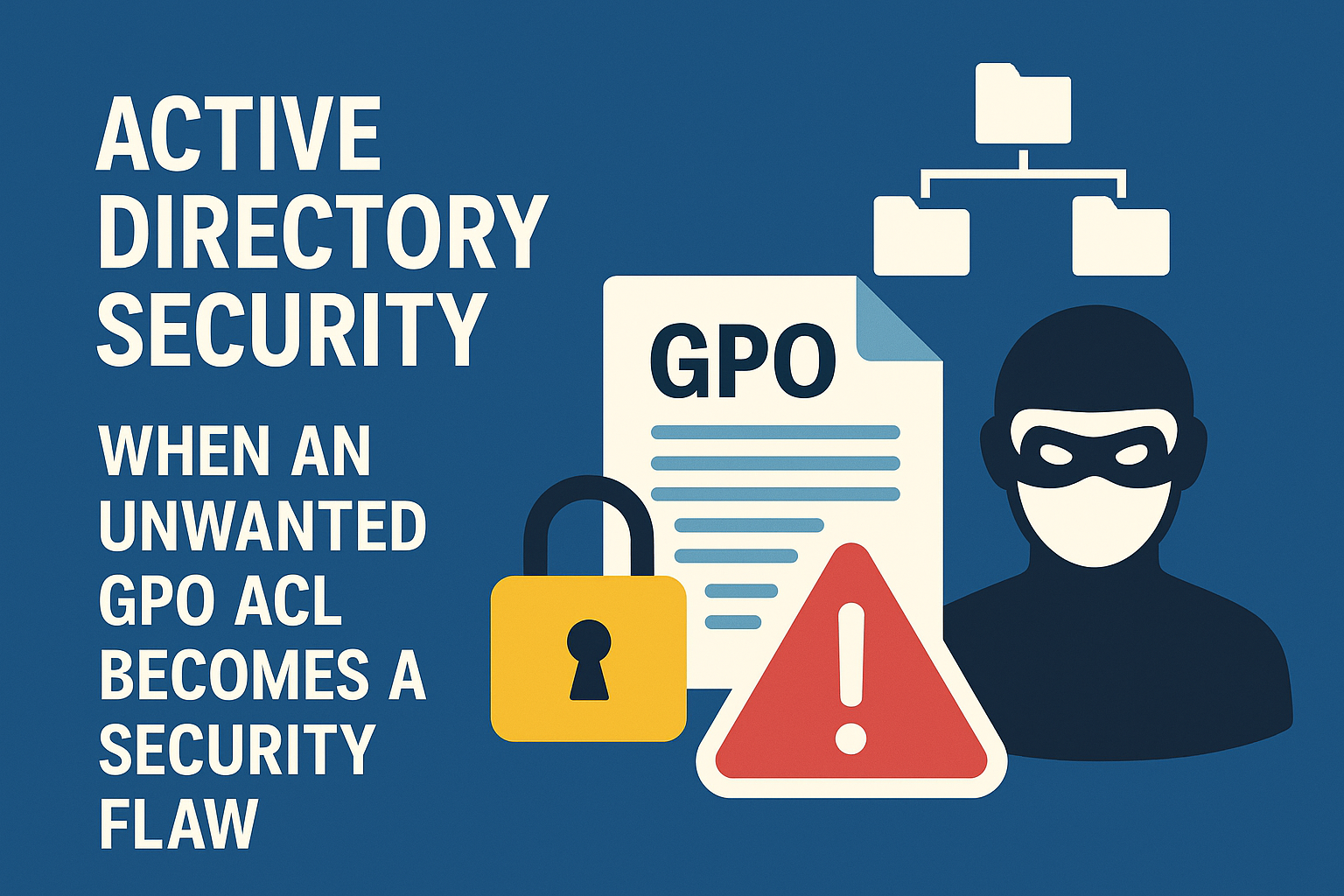Active Directory Security: When an Unwanted GPO ACL Becomes a Security Flaw
Active Directory (AD) forms the backbone of countless corporate networks, managing user identities and enforcing security policies. At the core of this control are Group Policy Objects (GPOs), powerful tools for administrators to configure user and computer settings across the enterprise. However, this power can be turned against an organization if not properly secured. An…
Active Directory (AD) forms the backbone of countless corporate networks, managing user identities and enforcing security policies. At the core of this control are Group Policy Objects (GPOs), powerful tools for administrators to configure user and computer settings across the enterprise. However, this power can be turned against an organization if not properly secured. An insecure Access Control List (ACL) on a GPO can create a significant security vulnerability, paving the way for attackers to compromise the entire domain.
This article will dissect how a seemingly minor misconfiguration in GPO permissions can escalate into a full-blown security breach. We will explore the fundamental components of Active Directory and GPOs, illustrate a step-by-step compromise, and outline crucial countermeasures and remediation strategies to safeguard your environment.
I. Presentation
Group Policy Objects are instrumental in defining the digital workspace for users and ensuring consistent security settings across a network.[1] They can dictate everything from password complexity to which applications a user can run. But when the permissions governing these GPOs are too lenient, they become a prime target for attackers. A malicious actor who gains the ability to modify a GPO can effectively dictate policy to any computer or user affected by it, leading to widespread compromise.
II. About the Audit of AD
A comprehensive audit of your Active Directory environment is the first line of defense against GPO-based attacks. This audit should pay close attention to the interconnected components that, if misconfigured, can create a perfect storm for a security incident.
A. Usage of AD Shares
Active Directory relies on network shares, primarily SYSVOL, to replicate GPO data across all domain controllers. The Group Policy Template (GPT), which contains the actual policy settings like scripts and administrative templates, resides within the SYSVOL share.[2] This means that any user with write access to the GPO’s folder within SYSVOL can potentially alter its behavior.
B. Architecture of a GPO
A Group Policy Object consists of two main parts:
- Group Policy Container (GPC): An object within the Active Directory database that stores metadata about the GPO, such as its version and status.
- Group Policy Template (GPT): A directory structure located in the SYSVOL share that holds the files containing the GPO’s settings.[2]
These two components work in tandem to apply policies to sites, domains, or Organizational Units (OUs).[3]
C. ACL Rights on a Shared Folder
Access Control Lists (ACLs) are the gatekeepers of your Active Directory objects. They define which users and groups have permissions to read, write, modify, or take full control of an object, including GPOs. Incorrectly configured ACLs are a common and critical vulnerability.[4] Granting a non-administrative user write permissions on a GPO is a direct invitation for malicious activity.[5]
D. What happens in case of a bad configuration?
A misconfigured GPO can quickly become a powerful tool for an attacker.[4] With the ability to edit a GPO, a malicious actor can:
- Execute malicious scripts: Attackers can add scripts to a GPO that will run at computer startup or user logon, giving them the ability to execute code on numerous machines.[5]
- Elevate privileges: A compromised GPO can be used to add an attacker’s account to the local administrators’ group on affected computers.[5]
- Disable security measures: Attackers can leverage GPOs to turn off firewalls, antivirus software, and other critical security protections.[5]
- Deploy ransomware: History has shown that attackers utilize compromised GPOs to spread ransomware across entire networks.[3][6]
Tools like BloodHound and PowerSploit can be used by attackers to easily identify accounts that have dangerous permissions over GPOs.[7]
III. Illustration of the Compromise Process
To understand the real-world impact of a vulnerable GPO, let’s walk through a common attack scenario.
A. Step 1: Creating the script
The attacker’s first move is to craft a malicious script. This could be a simple batch file or a more sophisticated PowerShell script designed to perform actions like adding a user to the local administrators’ group.
B. Step 2: Modifying scripts.ini
If the attacker has gained write access to a GPO’s files in the SYSVOL share, they can navigate to the GPO’s directory and edit the scripts.ini file. This file dictates which scripts should be run at startup, shutdown, logon, or logoff. The attacker can simply add a new line to this file, pointing to their malicious script.
C. Testing the script
Once the script is in place and scripts.ini is modified, the attacker only needs to wait. Group Policy automatically refreshes on client machines, typically every 90 minutes. When the policy updates, the malicious script will be executed with the permissions of the context it was launched in (e.g., as the SYSTEM account for a startup script).
D. Variant: Injecting parameters via Registry.pol
Another avenue of attack is to modify the Registry.pol file within the GPO’s folder. This file contains registry-based policy settings. By editing this file, an attacker can alter a vast array of security configurations, such as disabling User Account Control (UAC) or weakening firewall rules. Modern attack tools can even exploit GPOs through NTLM relaying, allowing an attacker to abuse a user’s GPO permissions without even knowing their password.[2]
IV. Countermeasures
Defending against GPO-based attacks requires a proactive and layered security strategy.
- Enforce the Principle of Least Privilege: Strictly limit the number of users who have write permissions on GPOs. Regularly audit these permissions and remove any that are not absolutely necessary.[4]
- Conduct Regular Audits: Continuously monitor GPOs for any unauthorized or suspicious changes.[4] Tools designed for Active Directory security can provide real-time monitoring and alerts for GPO modifications.[6]
- Implement Secure GPO Linking: Be judicious about where you link GPOs. Linking a GPO with risky settings to a high-level OU can have widespread consequences.[4]
- Utilize UNC Hardened Access: This security feature helps to mitigate attacks that attempt to redirect clients to malicious file shares.[8]
- Maintain Account Hygiene: Regularly identify and disable inactive or stale user accounts to reduce the potential attack surface.[9]
V. Remediation
If you suspect a GPO has been compromised, swift action is critical.
- Identify the Compromised GPO: Use auditing logs and tools to pinpoint which GPO has been maliciously modified. Sorting GPOs by their modification date can often reveal the culprit.[10]
- Disable the Malicious Policy: Once identified, immediately disable the GPO to prevent it from further affecting your environment.[10]
- Restore from a Known-Good State: Revert the GPO to a previous, secure version from a backup.
- Address the Aftermath: If the GPO was used to deploy malware or create unauthorized local administrators, you will need to clean up all affected systems.
- Investigate the Root Cause: A full investigation is necessary to understand how the attacker gained access and to close the security hole to prevent a recurrence.
VI. Conclusion
The power and reach of Group Policy Objects make them a double-edged sword. While essential for efficient administration, a single misconfigured ACL can open the door to a catastrophic network compromise.[11] Attackers are well aware of this and actively seek out these vulnerabilities.[3] By embracing a security posture founded on the principle of least privilege, continuous auditing, and proactive defense, organizations can harness the power of GPOs while mitigating the significant risks they can present. Securing your Active Directory is paramount to protecting your entire IT infrastructure.



